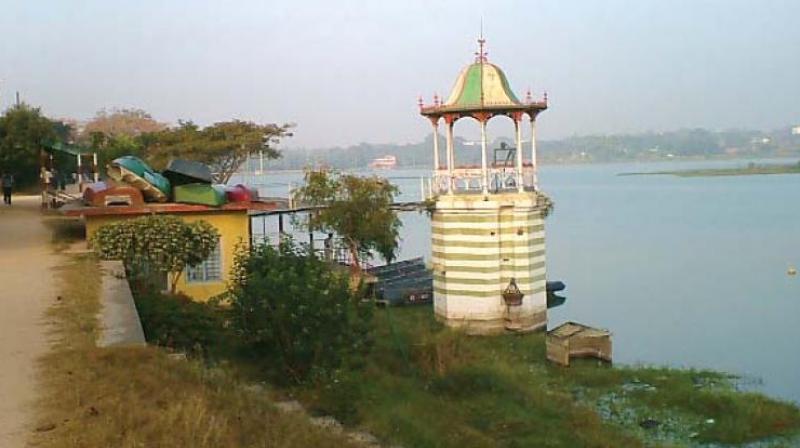Telangana: Temple, shrine encroach lake

Hyderabad: When minister K.T. Rama Rao visited the Ibrahim Cheruvu in April this year, people assumed that the long-neglected lake would finally be revived. But three months later, there has been no change in the condition of the 77-acre lake of Neknampur village. A temple and a graveyard are the latest causes of worry. The temple, which lies adjacent to the lake, was officially recorded on the survey map of 2013. Locals say that the temple-keepers are extending the temple by increasingly encroaching upon the lake, and dumping construction debris into the water body.
This observation is corroborated by Mr Dayanand, GHMC’s deputy executive engineer. There is also a graveyard on both sides of the bund. A portion of land was originally allotted to the locals, but new graves have begun appearing in areas where the lake has dried up. GHMC officials say that the appearance of new graves on the lake bed is highly problematic. Ushesh Reddy, the head of the village panchayat, says that people have begun using the lake area because there is no government land available at the moment. The villagers have been promised a plot in the adjoining village.
Revenue officers who are in charge of removing encroachments say that there have been no new invasions. MRO Savitha says that six houses and parts of a masjid, that encroached upon the lake, have been demolished. She adds that no new graveyards have come up in the area. Locals allege that officials are allowing affluent realtors to take up construction within the lake’s buffer zone, leaving no room for the promised lake beautification project.
There are buildings which have come up right next to the lake bund. But Mr Ushesh denies that there has been a breach of regulations. “The HMDA report says that these are residential areas, and they do not fall within the buffer or full-tank level zones,” he says. Experts say that a buffer zone of at least 30 metres must be maintained around the full-tank area of a lake. At present, the lake has no buffer zone on its western front, and the area is at risk of being inundated during heavy rains.
Study: City lakes, least encroached
While the city’s water bodies continue to be under threat from land sharks, there is a bit of good news. A study done by the Centre of Social and Economic Welfare, the ministry of urban development, shows that Hyderabad’s water bodies are less encroached upon than those other cities. The total percentage of loss of water bodies due to encroachment is pegged at 10 per cent in Hyderabad, whereas it is 79 per cent in Beng-aluru, 50 per cent in Chennai, 75 per cent in Kolhapur and 50 per cent in Thiruvan-anthapuram. Encro-achment on water bodies is worst in Surat (95 per cent) and Raipur (80 per cent).
Dr S Jeevananda Reddy, convener of the Forum for a Susta-inable Environment, who has fought several cases to conserve lakes, says the fight to protect dwindling lake areas started in 2001, when the Hyderabad collect-orate organised a wa-ter conservation mission to protect lakes in HUDA area spreading cross 2500 hectares. “Since then, many environmentalists and activists have been on their toes to defend lakes from grabbers. But, despite the fight, even today, land filling has not stopped,” he says.
Dr Subha Rao, who is adviser to the Centre for Climate Change, agrees that “we are not free of encroachments. Grabbing in Hydera-bad still happens by manipulation of the existing Revenue act. Deliberate encroachment is less but converting shikam patta land to commercial la-nd has happened more in the twin cities, and conservation of lakes for other purposes happened more in undivided AP.”

